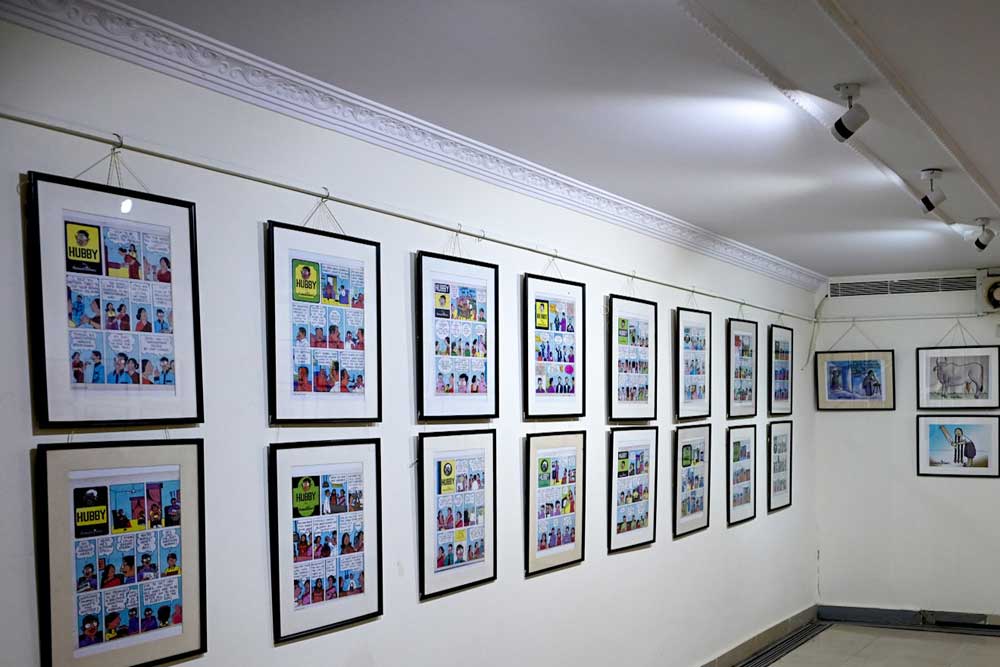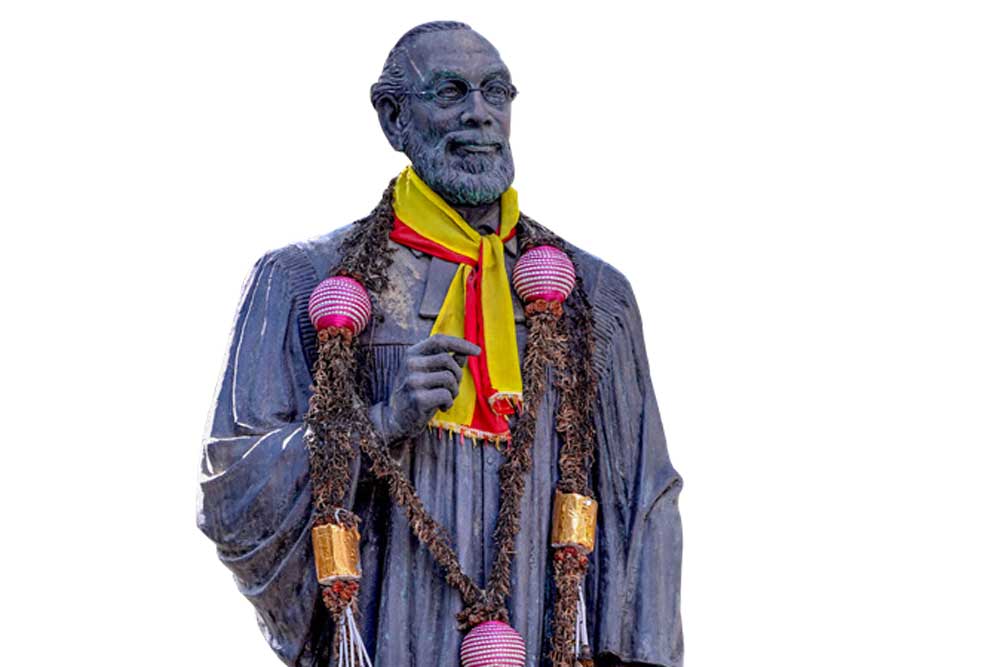At a crowded junction in Central Bengaluru, Ferdinand Kittel stands tall and quiet. Spectacles rest on his nose, a yellow and red scarf (the colours of the Karnataka state flag) drapes his neck, and a wilted flower garland hangs loosely. His hand rests on a book atop a table—perhaps a model of the Kannada-English dictionary he compiled in 1894. Beneath the heavy weight of this book, which houses 70,000 words, hangs a cross. In a tiny corner of the statue, someone has placed a miniature Ganesha idol.
The statue of German Indologist and poet Kittel, almost hidden by a canopy of tall trees, stands in the vicinity of an Army headquarters, an old Hindu temple, a metro rail bridge, a city civil court, and the Rajendra Sinhji Institute. The beautiful green zone dedicated to the man of words, is a resting place for street vendors. None of whom can, perhaps, read or write.
The place seems metaphorically apt, to begin a literary walk around the heart of Bengaluru. Veteran travel writer Zac O’ Yeah, who has crafted a terrific and ‘tourific’ self-guided book walk, however, recommends Avenue Road’s Rice Memorial Church as the starting point. The Rice Memorial Church located on the busy Avenue Road, is named after Rev Benjamin Holt Rice, a missionary of the London Missionary Society. His son Benjamin Lewis Rice is a notable epigraphist, and linguist whose fascination for the Kannada language led him to print several Kannada literary texts such as Catalogue of the Sanskrit Manuscripts in Mysore and Coorg, and volumes of Epigraphia Carnatica.
Copies of the latter can be referred to at the Mythic Society library on Nrupatunga Road, a well-maintained treasure trove of literature, history, archaeology, etc. Nrupatunga Road is named after 8th-century monarch Amoghavarsha Nrupatunga who wrote Kavirajamarga one of the earliest available works on rhetoric, poetics and grammar in Kannada.

The twenty-three-year-old Indian Institute of Cartoonists promotes and preserves cartooning and cartoonists in India, the gallery hosts rotating exhibits focusing on different artists
Share this on 

A literary walk promises one a journey through a city’s literary landscape. One gets a chance to see the city anew as the random statue that one had passed but never observed suddenly springs to life, as one now notices the book it holds and learns about the many tales behind the person. A literary walk in Bengaluru makes one encounter both the familiar and the unfamiliar. One can drop into the city’s many iconic bookshops and sniff an old book, or stumble upon a note left by a fellow bibliophile in its preloved pages.
In his essay, ‘Walking Tours’, Robert Louis Stevenson writes, “A walking tour should be gone upon alone, because freedom is of the essence; because you should be able to stop and go on, and follow this way or that, as the freak takes you; and because you must have your own pace, and neither trot alongside a champion walker, nor mince in time…”
The walking tour created and curated by Zac allows one to discover treasures at one’s own pace. The Tourific self-guided tours app is available for download on Google Play Store and Apple App Store. This pauseable and readable recorded tour takes one through 27 spots of literary significance. Zac includes the right dose of humour, less-known facts and neat anecdotes. Through his tour one learns of the city’s heritage, its present, and even the occasional ghost story.
Legend has it, in the early 1800s, Residency Road was home to a British official known by the title, Mysore Resident. His official residence stood near the corner of Convent Road and also housed a thug jail. Prisoners were hanged just across the street. Zac found this detail about the thug jail on an 1854 map and points out that this stretch of the street might just be the most haunted in town.

A statue of Ferdinand Kittel, best known for his studies of Kannada
Share this on 

Church Street, less than a kilometre long, boasts a dozen or so stellar bookstores. A bibliophile or even a casual reader is spoilt for choice here—Book Home, Book Hive, Bookworm, Blossoms (with its many branches), Gangarams, and more. These bookshops, tucked between franchise stores, cafes, and bars, stand like silent sentinels keeping ‘word-ly’ pleasure alive in a city obsessed with ‘worldly’ ones. Many of these stores keep books in circulation by buying back preloved editions and offering them for resale. As Zac aptly puts it, “It’s hard to think of any place on earth with a higher concentration of literature.”
At the 80-year-old antiquarian bookstore named Select Bookshop on Brigade Road, one can spot black-and-white photographs casually placed on top of the book stacks. Sanjay Murthy, third-generation caretaker of the shop says, “There is a fondness for old books because they always come with something in them. A photograph, a handwritten note.”
One of the stops on the tour is the Indian Institute of Cartoonists (IIC) that runs a gallery at Midford House and an annual magazine on humour and satire. Twenty-three-year-old IIC promotes and preserves cartooning and cartoonists in India, the gallery hosts rotating exhibits focusing on different artists. I come across a 1974 copy of Hasyam and flipping through the pages marvel at the old ads and articles. A few newer prints are available for purchase as well. Another rare find I encounter here is political cartoonist Surendra’s Tree Toons, which has nature-based tragicomic cartoons in English and Telugu, that he put together as a break from the antics of Indian politics.
Is it legit to carry one’s own book for reading on a book walk? Where does one go to sit and read while on a break from the book walk? Zac recommends several places where a one can indulge in coffee, beer, food or quiet reading.
Not many new residents living in Bengaluru seem aware that the Hard Rock Cafe of the last two decades, was once a building dedicated to reading and books, albeit of the religious kind. If one tilts their head high enough from the fancy advertising, one can spot ‘Book Society’ engraved in the building’s century old stones. It has changed many avatars, from a tea room for the English, to a showroom for Oxford University Press, and then an Indological bookshop full of academic tomes and scholarly treatises. If one strolls from this building up to the MG Road metro station passing the Deccan Herald newspaper office and Higginbotham, once the bookstore of the Royals, one can picture what colonial Bangalore’s main street once looked like.
Having walked on the streets of many world cities such as Shanghai, Athens, Ho Chi Minh City, Cairo, Liverpool, Istanbul, Helsinki, New York, Tangiers looking for treasures, Zac feels that the best thing one can do is be energetic and open-minded—the longer one is prepared to walk, the more one finds. His advice appears part philosophical, “Any bibliomaniac will know that taking on a bookshop and getting to know its soul is a journey of discovery. It is like a treasure hunt—you can’t expect to find the treasure at the start of the journey. And as they say, often the journey itself is the biggest reward.”
Zac shares there might be a version 2.0 of the literary walk in future with Basavanagudi, Gandhi Bazar, Malleswaram etc on the list. “Bengaluru, as a whole, is a fascinating city with plenty of authors living in town, the best bookshops in the world, and many unexplored literary connections,” he says.
One of my last stops was a one-of-its-kind bookstore at Avenue Road that has been grounded in literature for 50 years, albeit in a language that is neither native nor colonial. Vidya Mandir was started by Parmanand Gupt, a Hindi professor at St Joseph’s College in 1975 to cater to the Hindi literature and language needs of Hindi speakers in Southern India. The store’s current caretaker, his daughter-in-law, Ashu Gupta dreams of starting a book cafe with the late professor’s private collection of over a thousand Hindi books. While at the store, one may overhear the lady answering telephone enquiries for books, especially dictionaries. Which takes me back immediately to Kittle standing tall under a canopy of trees with his hand on a dictionary, listening to the cry of birds overhead.
More Columns
The Pahalgam Attack: Pakistan’s bid to distract attention from troubles at home Saleem Pandit
Mossad unearths 'proof' of opposition's links with anti-Adani campaign Open
PM Modi vows to pursue Pahalgam terrorists, backers to the ends of the earth Ullekh NP